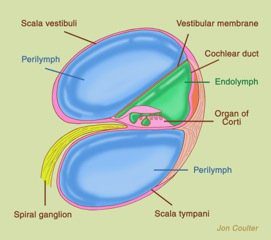By Barry Keate
Barry Keate, has lived with tinnitus over 40 years and has published 150+ research articles on numerous aspects of tinnitus. He is an expert on the condition and a well-known advocate for those with tinnitus.
A perilymph fistula (PLF) is a defect, or at times, a tear in one or both of the small, thin membranes between the middle and inner ears. The symptoms of PLF include hearing loss, tinnitus, ear fullness, dizziness, vertigo, imbalance, motion intolerance, nausea and vomiting. Usually patients report an unsteadiness which increases with activity and which is relieved by rest. (1)
Perilymphatic fluid from the fluid-filled inner ear leaks through a tear (fistula) into the air-filled middle ear. The fistula normally occurs in the thin membranes that surround the inner ear, the oval window and the round window. With less frequency it can also occur in the bone of the ear.

Pressure sensitivity is a symptom that is common in PLF. Changes in air pressure that occurs in the middle ear, like when ears pop due to altitude changes, do not normally affect the inner ear. However, when a fistula is present, changes in middle ear pressure directly affect the inner ear, over-stimulating the balance and hearing structures and causing symptoms. Therefore, people with PLF notice their symptoms worsen with coughing, sneezing, blowing the nose, and with exertion and strenuous activity. They will almost always become dizzy after descent in an airplane due to pressure changes in the cabin.
Head trauma is the most common cause of PLF, usually involving a direct blow to the head or ear. In some cases, whiplash injury can cause a fistula. PLF may also develop after rapid or profound changes in intracranial or atmospheric pressure, such as may occur with SCUBA diving, aerobatic maneuvers in airplanes, weight lifting and childbirth. (2)
PLF can also be caused by stapedectomy surgery for otosclerosis. Stapedectomy, by necessity involves the creation of a fistula for the insertion of the prosthesis. PLF occurs when the fistula created at the time of surgery persists and fails to seal off the vestibule from the middle ear. Symptoms can last for several weeks.
Most symptoms caused by PLF are synonymous with those of Meniere’s disease. It is important to understand the difference between these two conditions. There are two separate fluids in the inner ear, endolymph and perilymph. Meniere’s disease is a condition where endolymph comes under increased pressure and dilates the membranes in which it is contained. This increased pressure displaces the perilymph. The pressure relationship between the two fluids change and this causes the symptoms of Meniere’s, which are remarkably similar to PLF.
In PLF, the perilymphatic fluid leaks into the middle ear. This also causes a change in the pressure relationship between the two fluids resulting in similar symptoms.

There is considerable controversy about how to diagnose PLF versus Meniere’s disease, which is much more common. Since symptoms are similar, a diagnosis of PLF made in patients without head or pressure trauma can be questioned. A diagnosis of PLF is most certainly incorrect in situations where there is no reasonable cause or when bilateral PLF is diagnosed.
There are several tests that can be utilized to distinguish between the two. Audiometry tests and MRI are almost always used. There is also a Fistula test that makes a sensitive recording of eye movements while pressurizing each ear canal with a small rubber bulb. A positive test is good grounds for further exploration.
It is very important to obtain an accurate diagnosis because treatments for the two conditions vary dramatically. In Meniere’s disease, medications are commonly used along with an endolymphatic shunt, which relieves endolymph pressure. These are not helpful for PLF.
In many cases, a fistula will heal itself if a person’s physical activity is markedly restricted. In such cases, strict bed rest may be recommended to give the fistula a chance to close.
If symptoms are severe and have not responded to bed rest, or if progressive hearing loss has occurred, surgical repair of the fistula may be required. This procedure involves placing a graft over the fistula in the oval or round window.
Persons with PLF should avoid lifting, straining, bending over, popping the ears, forceful noise blowing, air pressure changes, high-speed elevators and SCUBA diving. All of these will worsen symptoms and prevent the fistula from healing.
References:
1 – American Hearing Research Foundation, http://american-hearing.org/disorders/perilymph-fistula
2 – Vestibular Disorders Association, http://vestibular.org/perilymph-fistula
Get Free Shipping!
Order now and get free shipping on either the Tinnitus Starter Kit or Combo Pack. Try the doctor recommended products with clinically proven ingredients for tinnitus. No coupon code required.

